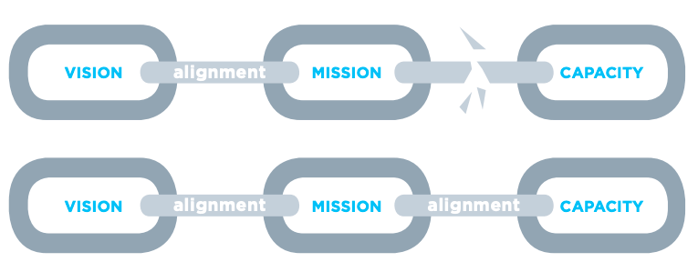Capacity and Mission Must Be Aligned
 Derek & Laura Cabrera
·
2 minute read
Derek & Laura Cabrera
·
2 minute read
This post is an excerpt from Chapter 4 of Flock Not Clock.
When the linkage between capacity and mission is broken or “de-coupled” (i.e., when capacity does not directly serve the mission), systems (departments, teams, processes) can regress to a state in which their purpose is maintaining themselves rather than furthering the larger organizational mission. These systems can unknowingly adopt the implicit vision of being self-sustaining and do mission (repeated daily actions) that further that end state instead of furthering the organization’s vision.
 Figure 4.4: Mission and capacity: aligned versus unaligned
Figure 4.4: Mission and capacity: aligned versus unaligned
A system becomes bureaucratic when its purpose is de-coupled from the mission of the organization and therefore it has an alternative purpose for existing—which is often just to further its own existence. Although the term bureaucracy has alternative meanings in management science (some of them that don’t have negative connotations) it is widely considered in the public usage to be negative. It usually refers to a company or system that is hindered by unnecessary red tape or inefficiencies. As we define it, bureaucracy—the de-coupling of capacital systems from the organization’s mission—can be incredibly costly. One way to measure the broken link between mission and capacity is to identify and measure bureaucracy within an organization. At a multinational level, excess bureaucracy costs the 35 member countries of the Organization for Economic Co-operation and Development (OECD) a total of 9 trillion dollars. For the United States, these costs amount to more than 3 trillion dollars in lost VISION alignment MISSION CAPACITY VISION alignment MISSION alignment CAPACITY economic output, this amounts to around 17 percent of the U.S. GDP.
Gary Hamel and Michele Zanini determined the excess costs of bureaucracy for a 2016 Harvard Business Review article through detailed economic analyses that found that if 15% of employees were re-deployed to focus on value-creation, mission-driven activities, they would each contribute an additional $141,000 in economic output per year. This increased productivity would significantly grow the U.S. GDP. In this new mental model, employees are re-assigned to value-creation tasks and are more likely to be satisfied with their work and more productive, thus producing more economic output.
Many industries recognize the negative impact of bureaucracy on an organization’s mission. For example, leaders in the pharmaceutical industry argue that the only way to reduce drug discovery costs and increase research and development (R&D) productivity is to disassemble excess bureaucracy. To start, as suggested by Roger Perlmutter, president of Merck Research Laboratories, companies would need to “scrape off the top five levels of management, including myself.” From a healthcare perspective, researchers have found that excess bureaucracy in the form of higher administrative costs often does not translate in better care for patients. In other words, the existence of excessive administrative systems works against the primary mission of the organization. But is this model too simplistic? The cost of bureaucracy may vary depending on the industry or organization. A simplistic model to understand the cost of bureaucracy in for-profit organizations would be to look at the general and administrative expenses versus cost ratio. Although a portion of general and administrative expenses are necessary capacity systems that drive mission, they are often inflated. When assessing the expenses as a percentage of revenue over time, organizations should seek a fixed or declining ratio. This outcome would ensure that bureaucratic expenses are not inflating in comparison with revenue-generating activities, which are often more direct ways to accomplish mission. It is important to note the importance of many systems that indirectly contribute to our mission, such as human resources, purchasing, and so forth. These systems are necessary to maintain the organization's existence, and therefore, to the ability to do mission. Analyzing our organization's capacity to do mission must therefore include all systems that are directly or indirectly tied to mission. This helps us determine if there is, in fact, any inflation or redundancy in our system that can be streamlined for increased efficiencies.
 The more important question to answer is: how closely are any systems (administrative or revenue-generating) tied to the mission? This is why it is so important to establish a clear and measurable mission, allowing us to determine the degree to which various systems contribute their capacity to the mission.
The more important question to answer is: how closely are any systems (administrative or revenue-generating) tied to the mission? This is why it is so important to establish a clear and measurable mission, allowing us to determine the degree to which various systems contribute their capacity to the mission.
.png?width=150&height=150&name=CRL%20GOAT%20Logo%20(4).png)



